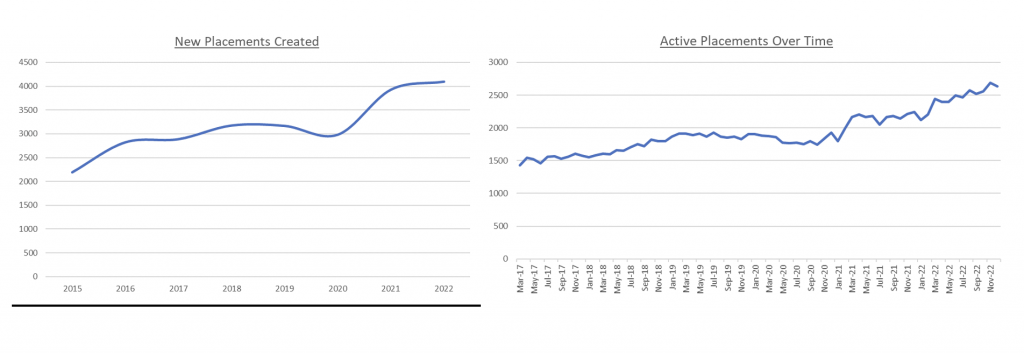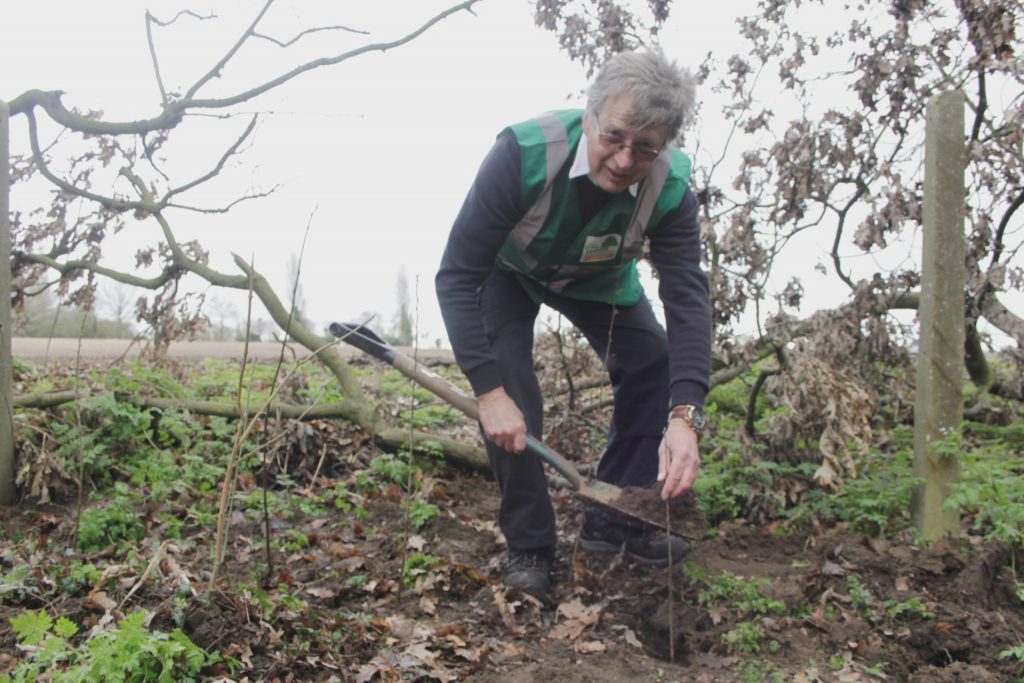|
|
 Added Health – Dr Michael Stein (left) and Prof Chris Butler The way we deliver healthcare in the UK has to change, says Dr Michael Stein, CEO of Added Health. He explains how advances in medical research and digital technology might now transform the lives of millions and save the NHS £billions.
The NHS is a powerful force for good. It has been brilliant, and highly efficient, at delivering care when we fall seriously ill. But the COVID pandemic has made plain a huge problem. It can be equally poor at stopping us from getting ill in the first place.
This has contributed to the pandemic tipping the UK further into a health crisis. By the start of 2023, there were more than seven million people waiting for NHS treatment. Millions more people have been left suffering chronic physical and mental health conditions.
The adage ‘prevention is better can cure’ has never been more true. At Added Health, we call it ‘pre-emptive health’ – tackling behaviours before they impact on long-term health and life chances.
Added Health is an app that, uniquely, provides comprehensive care and support across five pillars of health and wellbeing – nutrition, exercise, sleep, wellbeing, and relationships.
We call it your Health HQ in your pocket. We are also the first personal health and wellness app to be CQC-regulated for screening and diagnostic services.
Based in Oxford, our aim is to provide our clients with long-term, affordable, tailored and research-based support, so they can live healthier, happier and longer active lives.
It is what the government wants, too. A 2019 Green Paper describes the need for a ‘national preventative healthcare strategy based on proactive, predictive and personalised prevention’.
Such a strategy will need to make full use of latest digital technologies to be adopted by patients and be scalable. It will need innovative thinking, from outside the NHS.
It will need to be low-cost, and use proven behaviour change techniques to drive results. And it will have to be evidence-based and comprehensive in its scope, to meet all needs.
That is precisely what Added Health aims to deliver.
Global brains trust
I co-founded Added Health in 2020 after witnessing the devastation caused by hidden poor health at first-hand. A brilliant NHS physician – a close friend and a former colleague – died suddenly in his 50s.
He had not known he had severe heart disease and suffered a massive heart attack. I was shocked that a leading doctor could be taken from us this way. How, I asked, can we stop this happening?
The answer is Added Health. I have developed the concept with co-founder Professor Chris Butler. Chris is Professor of Primary Care at Oxford University and Director of the university’s clinical trials unit.
He is also co-Chief Investigator of PANORAMIC, the on-going trials platform that assesses the efficacy of new COVID therapies.
From the beginning, we have wanted science and evidence to be at the heart of this new service. For example, Added Health draws on latest research showing how our physiological and nervous systems are interconnected.
Crucially, the service is delivered by caring, well trained coaches (guides) supported by technology, in that order. To be truly effective, technology must be used to enhance the human relationships essential to good health practice.
We are also building a global brains trust, drawing together experts like Microsoft’s Worldwide General Manager of Health, Neil Jordan, and Mayo Clinic cardiologist Charles Cannan, to help guide Added Health’s development.
Motivating change
So, how does Added Health work?
A client who signs up for our service completes a detailed questionnaire about their health and lifestyle. This is reviewed by a qualified doctor to identify if specific medical interventions may be needed.
Our client then has a consultation with a qualified and experienced coach to establish their goals. It may be to lose weight, or to improve sleep, or to address a chronic condition, such as diabetes.
Every coach is trained to use Motivational Interviewing (MI). This is a behaviour change technique – proven by many peer-reviewed studies, and used widely in the NHS – to enhance motivation and achieve goals.
MI was developed by psychologists Professor Steve Rollnick and Professor William Miller, and Chris Butler. Steve Rollnick is Added Health’s Head Coach and a member of our advisory board.
Based on insights from the questionnaire, guidance from Added Health doctors, and the consultation, the coach then draws up a personal plan, which is reviewed and agreed by the client.
Each plan’s implementation is supported with regular communication through text messaging and delivery of tailored content. This can include fitness plans, recipes for healthy meals, and behaviour change encouragement.
We’re developing content for specific issues, for example, weight loss, gut reset, gout, and – coming soon – menopause. Clients can also have further face-to-face consultations, if necessary.
Digital innovation
Central to this approach is the use of machine learning to best use the huge and ever-growing pool of anonymised health and lifestyle data we’re gathering.
Making clients feel their needs are met is critical to their progress. However, over time, more shaping of personal plans can be achieved using this responsive software, monitored by our doctors and coaches.
Tellingly, as long as there is an existing relationship established by an initial consultation, we have found delivering support through texting does not diminish its impact. Meanwhile, machine learning will allow us to drive continuous improvement, and deliver services at scale, at lower cost.
We have been accepting clients for less than 12 months. But early results are very encouraging. Take Simon, aged 50:
“Within six weeks, my cholesterol, blood pressure and urates were down, and I lost 7kg. I felt energetic and mentally sharper. The osteoarthritis in my hips was improved.
“So, I came off meds for cholesterol and gout because it’s under control naturally. By 12 weeks, I had lost 10kg, my waist was 2″ less and I remain off all meds still.”
Simon’s experience reflects Added Health’s enormous potential: chronic conditions eased, even eliminated; wellbeing and life chances improved; NHS costs reduced; all achieved with minimal input from hard-pressed GPs.
Business health
 A key area where we think we can make a real difference is in helping employers. They are increasingly anxious about the impact of poor health on their organisations, exacerbated by the COVID pandemic. A key area where we think we can make a real difference is in helping employers. They are increasingly anxious about the impact of poor health on their organisations, exacerbated by the COVID pandemic.
Research shows employees feeling below par can cost a business, on average, a lost month of productivity every year. Around 30% of employees have a chronic medical condition.
A survey of UK employers showed how between 2021 and 2022, absences increased 29% and ‘presenteeism’ by 18%. The number of people intending to leave their jobs increased to 41%.
In a 2021 study, McKinsey found effectively treating depression and anxiety could lead to a 4:1 financial return on investment in terms of improved employee health and productivity.
We want to work with employers to address these issues and realise the advantages that will follow. We can develop a programme bespoke to their needs, based on workforce profile and activity.
That rich pool of anonymised data can be used to understand an organisation’s health at a granular level to design a programme with specific objectives, for example to improve workforce happiness, productivity or employee retention.
Based on our results, key members of staff, who may be considering retiring early or reducing their hours because of debilitating chronic conditions, can get a new lease of life, with renewed energy and purpose that benefits both them and their employers.
Profound impact
We’re putting these concepts to the test with an imminent Added Health study with a group of employees at Oxford University. Another study will start soon with a cohort of primary care patients.
As a scientist, I want to see the results. But I am confident they will confirm this medically-led, coach-implemented, and technology-enhanced approach to pre-emptive health could profoundly improve personal health and NHS finances, if widely adopted.
The urgent need for change is now. What is exciting is we now have the know-how and the technology to make that change happen.
Dr Michael Stein MB ChB, BSc (hons) (UCT), D Phil (Oxon) is a health entrepreneur who has been developing new ways to deliver healthcare for more than 25 years. He also practised medicine in the NHS and carried out research and lectures in immunology and pathology at Oxford University.
 Caroline Davis By Caroline Davis, Head of Public Sector Leasing at Triple Point
We know the green transition must involve local authorities if the UK is to meet its net zero commitments. That 78% of local authorities in England declared a climate emergency, and many local authorities have already made their own commitments on reaching net zero is reflective of the urgency and desire to push for a greener future at the local level to improve living standards, support jobs, and attract investment.
The challenge is that soaring inflation and a shortfall of £3.4 billion estimated for council budgets in 2023-4 means that local authorities are under unprecedented pressure. Money is often not available to fulfil essential council services whilst meeting commitments to transition infrastructure and services away from fossil fuels. The solution: not letting local government face this task alone.
At such a time, non-bank lenders have a vital role to play in furnishing authorities with much-needed financing. Leasing can help authorities conserve cash, and spread the cost of the assets they need, while fulfilling their essential services for communities. This can come in the guise of leasing commercial vehicles, medical equipment, modular buildings, and IT equipment to public sector organisations such as NHS trusts, as well as councils, leisure centres, ambulance trusts, and schools across the country.
Fewer funds for green assets
Take Electric Vehicles (EVs), considered the key technology to decarbonising road transport – the highest emitting sector of the UK economy today. Decarbonising the sector requires all types of vehicles to go electric, from cars and vans, through to specialist commercial vehicles such as tippers and refuse collection vehicles (RCVs). It also requires the capacity of regional bodies such as local councils to deliver on this goal.
A survey taken at the beginning of 2022 showed that, although 81% of councils have an electric vehicle strategy in place, 84% of vehicles operated by councils are still diesel-fuelled. This is clearly a problem, but it’s also unsurprising. For example, diesel RCVs boast among the worst fuel economy of all major vehicle categories. They are also significantly cheaper than their electric powered counterparts.
Leasing EVs such as electric commercial vehicles (including specialist vehicles) therefore represents a solution. Budgetary constraints can prevent local authorities from acquiring EVs outright given the high initial costs. But by spreading the cost of acquisition over several years, the transition to greener roads can become a reality.
Flexible and Tailored Leasing as a solution for councils
At Triple Point, we take a flexible approach to meet the needs of each customer we work with. Understanding that environmental technology such as EVs are in a state of constant evolution, we react quickly to these changes and offer tailored solutions and flexible leasing terms which ensure that public sector operations face minimal disruption and are in-step with the latest technological developments.
Our Public Sector Asset Finance team has financed large numbers of vehicles and assets to local bodies with a combined worth of £439m since 2007. From funding PPE making machines for NHS trusts, to providing modular buildings and equipment to schools, Triple Point’s diverse portfolio and expertise in the public sector continues to support local authorities with the financial tools needed to benefit from updated assets and technology.
Financing vehicles for local authorities already plays a significant role in Triple Point’s portfolio and supplying councils with EVs for the green transition is set to be a growing area of importance for Triple Point as the transition away from fossil fuels gathers momentum. It is clear that the path to a successful green transition in the UK will have to involve local government, and in the coming years, it will be paramount that councils have the support and expertise of non-bank lenders to ensure that the UK fulfils its ambitions to become a global leader in combating climate change.
 Kyndryl (NYSE: KD), the world’s largest IT infrastructure services provider and Leader 2022 in the Gartner Magic Quadrant, Hybrid Cloud and Network Mobility, and the Department for Environment, Food and Rural Affairs (Defra) today announced a collaboration to help manage and support Defra’s core network infrastructure used to host and run their critical services, benefiting all UK citizens. The agreement will help Defra to reduce network risk and manage technical debt as it modernises its systems and continues with its journey to adopt cloud technology. Kyndryl (NYSE: KD), the world’s largest IT infrastructure services provider and Leader 2022 in the Gartner Magic Quadrant, Hybrid Cloud and Network Mobility, and the Department for Environment, Food and Rural Affairs (Defra) today announced a collaboration to help manage and support Defra’s core network infrastructure used to host and run their critical services, benefiting all UK citizens. The agreement will help Defra to reduce network risk and manage technical debt as it modernises its systems and continues with its journey to adopt cloud technology.
This is the first direct contract which Kyndryl has signed with Defra, having previously provided services to run and manage Data Centre Infrastructure and Networking, as part of a much larger, integrated and complex multi-supplier agreement. Defra has appointed Kyndryl under the G-Cloud 13 framework where Kyndryl offers multiple cloud services which are available to UK public sector organisations.
Kyndryl is uniquely placed to deliver these services, drawing on its depth and breadth of network and experience, and providing the practitioner expertise and knowledge together with technologies that help customers prepare for the next wave of cloud adoption with 5G-enabled edge and software-defined networking.
Public sector organisations need to balance cost efficiency with service quality to deliver improved customer experiences and increased positive outcomes. The need to digitally transform, adopt new multi-cloud hybrid infrastructure and platforms is critical for success. As this adoption happens, Kyndryl can advise, build and manage services to help organisations transform whilst providing service security and stability in legacy infrastructure environments as well as connectivity to sustain business continuity.
“Kyndryl is thrilled to sign its first direct contract with Defra to manage and support its core network infrastructure, which is used to host and run critical services in support of Defra’s strategic aims to achieve a cleaner, greener country. This underpins our continued ambition and focus to support the UK’s public sector and to drive better outcomes for citizens,” said John Chambers, Kyndryl United Kingdom & Ireland President.
About Defra – Defra is the government body responsible for improving and protecting the environment. Defra is a ministerial department, supported by 33 agencies and public bodies. Its aim is to grow a green economy and sustain thriving rural communities. Defra also supports the UK’s food, farming and fishing industries.
About Kyndryl – Kyndryl (NYSE: KD) is the world’s largest IT infrastructure services provider, serving thousands of enterprise customers in more than 60 countries. The Company designs, builds, manages and modernizes the complex, mission-critical information systems that the world depends on every day. For more information, visit www.kyndryl.com
- Referrals to children’s social services by schools have risen by more than 50 per cent in the last eight years
- 129,090 referrals were made by schools in 2022 – the highest number since reporting began in 2014
- New safeguarding software to transform the way local authorities and schools identify and address safeguarding concerns
Market leading safeguarding software company CPOMS has developed a first-of-its-kind solution to transform the way that local authorities work with schools to log and manage safeguarding concerns about children.
 John Wild CPOMS Engage works by allowing local authorities and schools to both use the same system, which provides them with access to dual registered students to receive and request information on specific students via a secured, shared contract.
Different departments within local authorities, including social care, early help and children’s services, schools and virtual schools can input information into one shared system allowing them to build up detailed chronologies relating to a pupil’s wellbeing.
With CPOMS Engage, updates are shared in real-time, eliminating the need for teachers and safeguarding leads to spend time copying and pasting concerns into reports, meaning that more time can be spent focusing on providing children with the support they need.
This method of monitoring, logging and securely sharing even the smallest of concerns will help agencies involved in the care of children to improve the way they communicate, helping to inform joint decision making and co-ordinated interventions that put the safety and wellbeing of children first.
Southway School in Leeds is one of the first schools to pioneer this new software.
Andy Percival, headteacher at Southway School in Leeds, added: “At Southway, we have first-hand experience of some of the challenges around monitoring and sharing safeguarding concerns of children with our local authority partners. We know that effective multi-agency collaboration is key to promoting the wellbeing of children and preventing any child from falling through the gaps.
“CPOMS Engage has already helped us to drastically speed up the way in which we share information with other agencies we work with. It has transformed our ability to work more closely with our partners and ultimately, ensure the children in our care get the support they need in a timely manner.”
John Wild, managing director at CPOMS said: “Schools and local authorities are under more pressure than ever before, and alongside this, the rising number of referrals made to social services highlights that children’s safeguarding continues to be a significant challenge for local authorities.
“It’s therefore vital that processes between local authority departments and schools are as efficient and streamlined as possible – and we’ve worked closely with local authorities and schools to develop a solution that directly addresses the challenges they are facing.
“It’s brilliant to have Southway School in Leeds pioneering this software to address the safeguarding challenges it is facing – and we’re looking forward to seeing more local authorities and schools collaborating in this manner.”
To find out more about how CPOMS Engage can support the secure sharing of safeguarding information across agencies, visit www.cpoms.co.uk/cpoms-engage-for-local-authorities/.
 David Trossell, CEO and CTO of Bridgeworks The public sector continues to promote and undergo digital transformation. The drivers for it range from a need to digitalise operations, to increase innovation and agility or encourage and permit easier collaboration across different Government departments and public sector organisations.
There is also a need for increased data transparency to comply with data protection regulations, to give the public confidence in how their data is used, for what purpose and details of the people using it. There is a claim that digital transformation creates a better organisational culture – a claim which may be disputed by some commentators.
Push for efficiency
With digital transformation comes an increasing amount of data. Spurring it on is the prerequisite for public sector organisations to become more efficient. However, even the UK’s National Audit Office (NAO) finds that His Majesty’s Government has a complex operational landscape.
This is partly due to the existence of legacy IT and ageing data – both of which the NAO considers to be sources of inefficiency, to the extent that they create “a major constraint to improving and modernising government services.” The argument is that poor quality data, legacy systems and networks increase the cost of public sector services.
The NAO adds: “Tackling legacy services is costly and complex, but continuing to use them is risky and commits government to even higher future costs and risks. Failure to modernise legacy systems exposes organisations to possible service disruption, operational failure and cyber-attacks. The increasing costs of maintaining legacy systems and loss of associated specialist skills is unsustainable in the long term.”
The NAO points out that evolution of modern government is considered highly important with an £8bn Spending Review commitment being promised in 2021 to invest in digital, data and technology transformation by 2025. The UK’s Prime Minister, Rishi Sunak, who was Chancellor of the Exchequer at that time, is continuing this commitment as expressed by the current incumbent of 11 Downing Steet, Jeremy Hunt.
AI drive, attainable ambitions
Chancellor of the Exchequer, Jeremy Hunt, recently announced a proposal to help drive artificial intelligence and to boost the UK’s information communications technology industry. Matt Hawkins, CEO and Founder of Cudo – a cloud infrastructure-as-a-Service (IaaS) platform – believes that the dreams of a Silicon Valley in the UK are achievable. That is certainly possible, and that’s despite the collapse of startup funding Silicon Valley Bank. The UK arm of which has been saved by HSBC for £1.
The Government is offering a proposed £1bn fund to encourage science and technology research. He concurs with the Chancellor that AI and Quantum computing are two exciting areas of focus. In fact, leaps forward have already been made over the last few years, and they will continue into 2023.
Legacy networks and systems
However, legacy networks and systems still exist in the public sector. As with commercial organisations, the solution of choice is to call for the modernisation of public sector network infrastructure – quite often with SD-WANs and with Secure access service edge (SASE). This is based on the view that what is old should be replaced by something modern in order to be efficient. Yes, there may be a need in some organisations to buy new kit – from storage to network infrastructure – but that’s not always the case.
There are, nevertheless, proponents of SD-WANs. Adam Stone writes for StateTech: “For many, SD-WAN — a software-defined approach to managing the network — offers a way forward. A virtual architecture that connects applications and users, it offers simplified management, policy templates and detailed performance reporting.”
“SD-WAN can help lower the cost of hardware, improve routing on the network, enable multicloud access and ensure the security and productivity of the hybrid workforce. It supports the rise of automation and can bolster modernisation efforts, such as identity and access management for citizen services.”
The push to modernise
Stone says government and public sector organisations are looking to modernise legacy technology, simplify network management and they are working to enable a hybrid workforce. His view is that Wide Area Networks have helped over the years, but he claims that conventional approaches have their limitations.
For example, Trent Shoultz, Senior Director of Systems Engineering for State and Local Government and Education at Palo Alto Networks in the US, argues that legacy WANs don’t optimise packet flow. They were never designed to do so, as they were not developed to deliver on Service Level Agreements (SLAs) based on application performance – especially with regard to cloud applications.
With legacy WANs, there has often been the need to manage disparate products manually, “adding significant cost and operational overhead”, he says before adding their lack integrated security, a liability for the modern dispersed enterprise.
Limitations of technologies
There is quite often an unspoken need to consider the limitations of technologies before investing in them, and before implementing them. This is no different when it comes to MPLS, WAN Optimisation and SD-WANs. Government and public sector organisations also need to keep an eye out for technologies that could enable ‘Modern Government Enterprises’ to keep their existing infrastructure going. This can be achieved, and would still be an efficient as well as an effective strategy, without adding the costs of investing in new systems, storage and modern network infrastructure.
Network speed also doesn’t have to be sacrificed, as network performance can be increased by mitigating the effects of latency and packet loss. Rather than focusing on bandwidth, public sector organisations could concentrate on increasing their existing bandwidth utilisation as, quite often, the advertised bandwidth of connectivity often falls short.
David Trossell, CEO and CTO of Bridgeworks, comments: “We find that the SD-WAN providers’ support for traditional data flows is now inadequate for today’s high-speed high-volume transfers, and the SD-WAN world is much larger than these providers.” He, therefore, wonders why so many organisations have turned to SD-WANs, and away from MPLS:
“SD-WANs have the ability to bring into play multiple differing transports and this involves combining them under one virtual WAN to address different WAN requirements”. He finds that SD-WANs can bring into play multiple differing transports, which oftens means that they are united under one virtual WAN to address different WAN requirements.
That said, all organisations – including in the private sector – are often happy to put up with limited network performance. The trouble is that “SD-WANs do not solve the problem of latency and its friend packet loss – both of which have a devastating effect on performance,” explains Trossell. MPLS also still suffers from it, albeit to a lesser extent, and so there is a need for a new approach to optimise bandwidth.
SD-WAN-WAN Acceleration
The answer is to deploy an SD-WAN-WAN Acceleration overlay. This offers the benefits of an SD-WANs, while improving network performance by using AI, machine learning and data parallelisation to mitigate the effects of latency bad packet loss, while boosting bandwidth utilisation. This can be done with a solution such as PORTrockIT, which is data agnostic and capable of sending and receiving encrypted data. Now that’s something that WAN Optimisation can’t do.
WAN Acceleration redacts the arguments that something old is essentially inefficient because PORTrockIT can be used to make existing network infrastructure more efficient without having to throw the baby out of the bathwater. This enables organisations – public sector and otherwise – to do more with less, while helping to keep data secure and by reducing the need for a manual human network and infrastructure management. To put it simply, WAN Acceleration saves time, money and resources. It can also significantly boost the performance of SD-WANs.
By Graham Jarvis, Freelance Business and Technology Journalist
- Moving Communities participation, financial and social value data offered key evidence to unlock new £63 million fund for leisure centres with pools
- Data shows pool usage highest among older adults, women and under 16s and contributed to more than £833 million in social value in 2022 – 85% of the total for the sector
Data from Sport England’s Moving Communities platform has provided key evidence in a recent decision to make a major new £63 million fund available to publicly-owned leisure centres with swimming pools. Critical to the decision was data that modelled the rising expenditures across the leisure sector, positioned alongside the potential loss in participation and social value.
Moving Communities is a Sport England driven initiative delivered by 4GLOBAL and a group of consortium members; Leisure-Net, Right Directions, and Sheffield Hallam University. Together, Moving Communities provides live data based on the largest data set ever gathered for the local authority leisure sector.
According to data from Moving Communities, between April and August 2019, the average utilities cost per site was £46,240. For the same period in 2022, the sector was facing a 70% increase with average costs rising to £78,442. For large facilities, there was an 82% increase from £60,542 to £110,469.
These results show the challenges being faced by the more than 2,000 public leisure centres in England, over 800 of which have pools. These facilities play a vital role in helping communities engage with sport and physical activity.
 Tim Hollingsworth OBE,
Chief Executive Tim Hollingsworth, Chief Executive Officer, Sport England added:
“We know the rising cost of energy, along with chemical shortages and staff retention have created a challenging landscape for the public leisure sector. We’ve been able to track this in real time through our Moving Communities service, alongside participation data across different activities to understand the wider social value generated from activity in these vital community facilities. Efforts from local authorities and their service providers in sharing this data have been integral to the funding decision and created a positive step change that can continue to show the impact of these centres moving forward.”
Data from Moving Communities showed that facilities containing both gyms and pools were estimated to create more than £833 million in social value in 2022 – 85% of the total generated for the sector. Social value combines data from several outcomes including the total savings in health and social care costs achieved through the reduced risk of various health conditions as well as the average annual costs per person diagnosed with the condition. It also includes improved educational attainment through sports participation, savings to the criminal justice system and the value of higher wellbeing derived by sports participants.
What’s more, over half of all leisure centre participants went swimming in 2022. Including both activities and lessons, this equates to more than 4.5 million people, which is more than any other leisure activity recorded by the platform. Of those swimming, there was a higher proportion of older, female adults participating, and over the course of 2022, 1.1 million people participated in swimming lessons. The vast majority (95%) of swimming lesson participants were under 16.
“The pandemic left the public leisure market in a vulnerable position after almost two years of closures and restrictions,” said Emma Bernstein, Strategic Project Lead for Sport England. “The new funding being made available to help these vital community resources through the financial pressures they face is a great start to support the sector as it moves toward a more sustainable operating model in future.”
“The hardest to reach demographics are the ones using pools the most,” continued Emma. “Continuing to ensure public access to swimming facilities is incredibly important to reduce inequalities in our communities especially for the larger proportion of older adults, women and young children who regularly use these spaces to stay fit and healthy. The data is clear. Pools play a vital role in communities, supporting hundreds of thousands of people each week.”
For more information about Moving Communities, go to www.sportengland.org/research-and-data/data/moving-communities
Following the announcement that the Household Support Fund has been extended again, Huggg, the specialist platform which allows organisations to send and manage retail vouchers at scale to those in need, has launched a number of new initiatives. These are designed to help local authorities and their Third Party partner organisations (TPOs) get these vital funds quickly and efficiently to recipients with vouchers to pay for groceries, clothing, essential household items and free school meals
This move acknowledges that whilst councils in England are best placed to decide how to spend their allocation to support people in their local area drawing from local knowledge and direct contact with people in the community, they often struggle with the additional workload. This includes mandatory marketing, detailed DWP compliant reporting and provision of redemption data.
 To provide further support on this, Huggg has created a guide to Delivering HSF with Impact, which includes templates such as delivery plans, working with TPOs, MI templates, as well as marketing plans, guidance and content for messaging that can be used across all media and social media platforms. For those councils that are using TPOs such as charities, housing associations and CAB to help administer the funds, the Huggg platform will also support with full transparency of how they are using the funds and links with reporting/controls. To provide further support on this, Huggg has created a guide to Delivering HSF with Impact, which includes templates such as delivery plans, working with TPOs, MI templates, as well as marketing plans, guidance and content for messaging that can be used across all media and social media platforms. For those councils that are using TPOs such as charities, housing associations and CAB to help administer the funds, the Huggg platform will also support with full transparency of how they are using the funds and links with reporting/controls.
Stefan Allsebrook at Huggg said: “The role of distributing the HSF funds is often given to hard pushed teams that have a heavy workload already and our platform enables them to work at scale and allow and distribute thousands of vouchers quickly and easily with built in reporting and redemption data. These new initiatives are designed to help further reduce time spent on planning and marketing the schemes and ensure that the funds are distributed quickly and efficiently.”
The Huggg platform is free of charge to public authorities and charitable organisations and enables them to send groceries, clothing and/or home essentials vouchers to recipients across the community. Each recipient can decide which retailer they will spend their voucher with, giving them the power and the dignity of choice. Huggg also provides 7 day a week support to both its client organisations and recipients.
 Julian Panter The number of active social care work placements have reached an all-time high, with average pay rates on the rise in an effort from businesses and councils to attract more candidates into vital roles, according to data from market-leading workforce technology and services platform Matrix.
Despite the rising need for social workers, data from the Department of Education showed that social workers are quitting in record numbers, with 5,400 leaving the profession in 2022, a 9% rise on the previous year – the highest since 2017. It showed that vacancies were also at a record high of 7,900 (+21% over 2021).
Matrix’s own internal data correlates to this trend, highlighting a 87% rise in new placements created between 2015 and 2022 and an 84% increase in active placements since 2017.
Among its top 4 social care clients, Matrix data shows an average 179% increase in the number of social care roles available since 2020, with councils responding to the social care crisis by offering a significant 20% increase in pay rates to attract more candidates to the roles.
Although pay rises in the sector are welcomed the London Councils collaboration is aiming to end bidding wars over children’s social worker pay and are collaborating more than ever before to avoid the rising costs of expensive agency staff. Boroughs say their unprecedented level of collaboration is reducing competition between one another over children’s social care staff. With boroughs also working more closely with agency suppliers of social workers, children’s services departments report they have better control of costs, as well as upholding high standards through more information sharing on references and improving retention rates.
“With social care workers quitting in record numbers, it’s vital that employers are not just working to improve conditions but also the rates of pay to help close this gap and attract and retain more candidates to take up these vital roles. Our association with the London Pledge and other associated Memorandums across the UK is integral to keep the various customers talking so as not to hike up rates unnecessarily.” says Julian Panter at Matrix.
In February this year, the government published a plan to overhaul the social care system – including “ambitious plans” to recruit up to 500 new child and family social worker apprentices and introduce more support and professional development for social workers in the first five years of their career.
 Barley Laing, UK Managing Director at Melissa With precious budgets under significant pressure due to high inflation and belt-tightening post-pandemic, it has never been more important to ensure funds are efficiently spent.
One important way is to gain insight, a single citizen view (SCV), of those on your database. This will facilitate the personalisation of communications and improve the delivery of services – which will have a positive impact on the user experience – along with improving operational efficiency. Also, obtaining a SCV will help to reduce the opportunity for fraud.
A major challenge to obtaining a SCV is data decay. Contact data degrades at 25 per cent a year without regular intervention, as people move home, get married, for example. An additional issue when it comes to collecting contact data at the user onboarding stage is that 20 per cent of addresses entered online contain errors. Spelling mistakes, wrong house numbers and incorrect postcodes are primarily caused by people mistyping their details into small keyboards on their mobile devices.
With simple and cost-effective changes as part of your data quality regime, incorrect contact data can be easily fixed to help deliver a SCV.
Cleansing and standardising held user data to deliver data quality in batch, as well as when new data is collected in real-time, is important. Furthermore, data can be enhanced by using cleansing tools that can fill in any missing contact details.
Autocomplete prevents inaccuracies at onboarding
Technology, such as address autocomplete or lookup, are vital in ensuring public sector organisations gather accurate address data in real-time at the onboarding stage by providing a properly formatted, correct address when the user starts to input theirs. By reducing the number of keystrokes required, by up to 81 per cent when typing an address, it also enables convenience. The onboarding process is speeded up, reducing the probability of the user not completing an application to access a service.
It’s not only about the address. The first point of contact verification can be extended to email and phone so that these valuable contact data channels can also be verified in real-time. This ensures organisations have the ability to communicate effectively with users, not just on the first occasion, but on an ongoing basis, and support the delivery of a SCV.
Match and dedupe
With the average database containing 8 – 10 per cent duplicate records, it’s a necessity to undertake data deduplication. Duplicate records are frequently caused when two departments merge their data and mistakes in contact data collection occur at different touchpoints.
Unfortunately, it can add cost in terms of time and money, particularly with printed communications, the delivery of which can also negatively impact on the sender’s reputation. Receiving more than one of the same communication will be viewed by many as an excess waste of public money by recipients, particularly at a difficult time for public sector finances.
To avoid such waste it’s important to utilise an advanced fuzzy matching tool to deduplicate data. It can merge and purge the most challenging records, making it possible to create a ‘single user record’ and obtain an optimum SCV. This will also maximise efficiency and cost reduction for those in the public sector because multiple outreach efforts will not be made to the same person. Another key benefit is the potential for fraud is reduced due to the creation of a unified record for each citizen.
Enrichment
The data cleaning tools sourced should be able to fill in any gaps in the contact data, for example, a missing telephone number, as well as correct them where required, which in turn will improve personalisation. This additional, accurate data will also aid those in the public sector to make learnings about their citizens, to further improve communications and their experience.
SaaS supercharges data quality efforts
It has never been easier or more cost-effective to deliver data quality in real-time. Today, you can access a scalable data cleaning software as a service (SaaS) platform that requires no code, integration or training. All that’s required is to plug in and benefit immediately. It’s technology that instantly cleanses and corrects names, addresses, email addresses, and telephone numbers worldwide. Records are matched in real-time, ensuring no duplication, and data profiling is delivered to help identify issues for further action. A single, intuitive interface provides tools for data standardisation, validation, and enrichment, resulting in high-quality contact information across multiple databases that will help to deliver a SCV.
Artificial Intelligence (AI)
Once public sector organisations have obtained accurate customer data, artificial intelligence (AI) can add significant value to the data they hold. For example, a type of machine learning called semantic technology can promptly deliver high value, in-depth intelligence on the users of your services, and therefore enhance your SCV. Semantic technology, or semtech, associates words with meanings and recognises the relationships between them. It works by delivering powerful real-time connections between records, combining the missing pieces of data to support an informed decision about the content of a communication to a user.
Prioritising the delivery of a SCV at a time when their budgets are under huge pressure is vital for those in the public sector. Obtaining and maintaining contact data quality is at the heart of this. Once you have data quality communications can be personalised, improvements can be made to the provision of services, and a standout user experience delivered. Additionally, public bodies will experience greater operational efficiencies and the opportunity for costly fraud will be reduced.
For more information about Melissa and how our data quality and identity verification services can help you, please visit: www.melissa.com/uk, email: barley.laing@melissa.com or call: 020 7718 0070.
The NHS is looking for a new chief information officer, and the Highland Marketing advisory board has been considering what should be on his or her ‘to do’ list.
Following the merger of NHSX and NHS Digital with the NHS England transformation directorate, and the departure of some high-profile digital leaders, the NHS is looking for a new chief information officer.
In the middle of March, NHS England announced that it had appointed John Quinn, the former head of the Medicines and Healthcare products Regulatory Authority, as interim NHS CIO. But there’s no indication when a permanent replacement for Simon Bolton will be found.
The uncertainty has contributed to health tech being – as one member of the Highland Marketing advisory board put it – “in a bit of a mess right now.” Against a paralysing backdrop of elective recovery, demand, financial pressure and strikes, providers and suppliers are trying to work out what the IT strategy is meant to be – and where the resources are going to come from.
As Andy Kinnear, a former CSU CIO who now works for Ethical Healthcare Consulting, put it: “We’re trapped between two worlds. We’ve got this exciting new world of digital that we see in other areas of our lives. And we’ve got this stale, old world of patching critical infrastructure and running after programmes that are run by people who feel a long way from the frontline.”
Quinn, and the new CIO when they are appointed, will have a lot on their desks, and the advisory board highlighted five of their biggest challenges as being to:
Reboot frontline digitisation: The frontline digitisation programme has been billed as an opportunity to complete the roll-out of electronic patient records to hospitals that was started 20 years ago by the National Programme for IT, while encouraging ‘convergence’ on infrastructure and core systems.
However, the Health Service Journal has reported that more than half of the £2.2 billion that was found for the programme in last year’s Autumn Statement has been clawed-back. And there is concern that, in some areas at least, the focus on convergence is skewing priorities in the direction of clusters of trusts adopting the same EPR from a single supplier.
Ian Hogan, chief information officer at the Northern Care Alliance NHS Foundation Trust, said: “NHS England is saying there are about 30 trusts without an EPR but, due to the reduced funding envelope, it looks as if not all will be funded for one. Where does that leave the rest?
“And if we can’t support 30 trusts to get an EPR, how can we support the other trusts to converge on one or two systems? You can make a case for convergence being the right thing to do, but at the moment it is just causing more confusion.”
Pick a future for the NHS App: The NHS has made a considerable investment in the NHS App but has seemed uncertain about what to do with it. Should its developers create their own information and transactional functionality? Or should they focus on providing identity and access services for third-parties?
 Or should the NHS let the app become one of many digital access points? The current health and social care secretary, Steve Barclay, seems keen to see the app widely downloaded and used as a ‘digital front door’ to the NHS; and advisory board members thought he should push on. Or should the NHS let the app become one of many digital access points? The current health and social care secretary, Steve Barclay, seems keen to see the app widely downloaded and used as a ‘digital front door’ to the NHS; and advisory board members thought he should push on.
Neil Perry, a digital health consultant who was, until recently, the director of digital transformation at Dartford and Gravesham NHS Trust, said: “The NHS App had something like 30 million downloads during Covid, so there is clearly an opportunity to build on that. And it should be a digital front door, ideally a nationally provided patient portal, from which the economies of scale would drive down cost and create standardisation. But more than a patient portal, key apps should be integrated and funded nationally, such as AI assisted diagnosis & symptom checkers that can reduce the overall burden on GPs, UTCs and emergency departments. All this would democratise patient facing tech across the UK.”
Advisory board chair Jeremy Nettle is passionate about this agenda. “I remember thinking, years ago, when we first heard that the ‘information revolution was coming’, that it was more likely to come from the public than the NHS,” he said.
“To some extent, that is happening, with the spread of GP apps and remote monitoring. But we need it to happen faster, because so many people are still ending up in hospital when they could be better treated elsewhere or staying in hospital when they could recover at home.”
Secure the med tech revolution: Medical technology is a hot topic. The government has just published the first-ever strategy to give UK patients access to safe, effective and innovative equipment ranging from syringes to medical scanners and from test kits to home dialysis machines.
Many of these devices will be connected to NHS networks or the public internet in one way or another, and Neil Perry argued there is an urgent need to think about how to regulate and secure them. “The med tech space is really important, but it is a hotch-potch at the moment,” he said. “There’s no consistent adoption, and the NHS needs to invest in making sure these devices are connected, data insights utilised and are made fit for purpose. This can really improve safety, efficiency, and effectiveness, reducing communication errors, increasing accuracy, and enabling faster diagnosis and escalation. I’d argue investing in a med tech Strategy or ‘smart hospitals’ would have a greater impact rather than refreshing a PAS and/or an EPR.”
Stop the talent drain: National leadership for NHS IT has been in flux since the merger of NHSX and NHS Digital was announced. But Andy Kinnear pointed out there have also been some high profile departures from integrated care boards and trusts.
 Highland Marketing advisory board At the same time, the NHS continues to lack the workforce and IT strategies that might help it to secure the digitally savvy clinicians, IT innovators and data analysts it will need in the future. Ian Hogan said: “This is one of the things that keeps me awake at night – alongside the old data centres, and the cyber security.
“The health service has had a cadre of IT leaders who are NHS through and through – I am probably one of them. But there’s fewer and fewer of us. Even when we recruit people, they do the job for a bit and then go somewhere else. It’s not just the money, or the hours, or the complexity. It’s the workload. You do 100-hour weeks to try and stay on top of it, and it’s just not sustainable.”
Reconnect with the frontline: This leads to the question of who the next, substantive NHS CIO should be. In some ways – the board argued – it might not matter. The present government will, almost certainly, be out of office within a couple of years. NHS England looks as if it will spend a good chunk of that time re-organising to cut costs and headcount.
Most of the national capital funding for NHS IT has been earmarked for frontline digitisation and then cut, so only small sums may be available for projects. Probably those that catch ministerial attention, like digital follow-up, or virtual wards, or bed management and patient flow systems – which are suddenly ‘the ‘solution’ for next winter.
As Andy Kinnear put it: “The political forces may be so huge that whoever takes on the job will have virtually no room for manoeuvre.” Even so, members felt it would help if the NHS could find a CIO with frontline experience.
“I think we need somebody who has been at the coalface; somebody who has a proper connection with what it is like to do the job in an acute environment,” said Ian Hogan. “Because it is just tortuous at the moment, and we need somebody who can bring a bit of realism to what is being demanded by the centre and what is possible.”
Pulling IT all together
The advisory board was divided on whether the merger of NHS England, NHSX, and NHS Digital will be a good thing in the end. Cindy Fedell argued it would be because “we do need IT to be blended with operations” and also “when NHS England says something, chief executives sit up and take note.”
However, entrepreneur Ravi Kumar reiterated that, for the moment: “It feels like the whole digital agenda is on hold. Plans are announced, but nobody backs them up. And the leadership has gone, so nobody fights for that money. Instead, it feels like a culture of survival has taken hold.”
Andy Kinnear argued that while the hiatus continues, the best thing ICB and trust CIOs can do is “crack on” and “use the space to do things locally” – although he wondered where innovation would come from, with SMEs and start-ups finding it so hard to get a toehold in the market and at risk of take-over by bigger players.
Looping back to his opening point, he said: “There is the fourth industrial revolution going on around the NHS, and there is the moribund state of things within it. For me, what the new CIO needs to do most is to provide challenge about that, and to work out a way to get from one world to another.
“They need to start by acknowledging that the past five years have achieved very little, and they need to engage regional and local leaders to be part of the way forward.”
 An impressive 500,000 energy vouchers dispatched within four weeks and ahead of schedule. An impressive 500,000 energy vouchers dispatched within four weeks and ahead of schedule.
A staggering £600m of cash distributed across post offices at speed, meticulous behind-the-scenes planning and postmasters who proved to be local heroes for their communities.
The results speak for themselves: With a redemption rate of almost 100%, it’s clear the Northern Ireland £600 Energy Bill Support Scheme’s (EBSS) voucher rollout has been a resounding success for Post Office.
The campaign has been championed by the now Department for Energy Security & Net Zero (DESNZ) and by Christopher Heaton-Harris, Secretary of State for Northern Ireland.
He chose to publicly praise the rollout on Twitter, posting “Great news for Northern Ireland households. Thanks to @Post Office and NI energy suppliers for their efforts in the quick delivery of this vital support.’’
So, what next for Post Office and its network of 11,500 branches across the UK?
Having ensured over £1 billion in cash payments, issued on behalf of the Government made its way into people’s hands in the last year alone, it appears one of Britain’s best-loved organisations has its sights firmly set on ‘owning’ the bill payments and cash disbursal space.
Behind the scenes of the NI energy voucher rollout & its success:
The Government’s (EBSS) rollout for Northern Ireland was agreed and completed within two months – a fantastic feat for Post Office.
However, up until the 11th hour, the Post Office found itself vying with PayPoint to be awarded the contract in the first place.
 Simon Lambert As Simon Lambert, Commercial Director of Payzone at the Post Office, explains: “We were approached by the now Department for Energy Security & Net Zero as a contender to oversee the Northern Ireland rollout around the middle of December. It was clear that there were two viable channels for the scheme.
“Customers in Northern Ireland have a higher cash centric approach to the energy market: around 75 per cent pay for their fuel with money or prepaid key and card, rather than direct debit. An energy redemption rollout would mean these customers would need cash-in-hand.
“This worked to the advantage of the Post Office as our ability to manage cash pay in and pay outs is unparalleled and we were very much in the frame because of our consistent delivery on other redemption rollouts. The evidence was clear: the Post Office is trusted to deliver, and the quality of the customer care provided by the postmasters is very much on the front foot.”
The scale of the cash payouts the Post Office potentially faced was huge: at least £300 million was the estimate once they factored every single customer wanting their voucher to be redeemed for cash. The amount distributed to post offices across Northern Ireland was then doubled to £600m ensure there would be no shortage of cash for customers.
This required working with police to help move the cash and ensure all post offices were prepared and had enough funds to pay out over a four-to-five-week period.
The Post Office worked with the Bank of Ireland and G4S and plans were also put in place for police officers to increase their presence outside or near post offices and pop in regularly to ensure postmasters and customers felt safe.
The enviable achievement in Northern Ireland is just the tip of a long line of impressive cash redemption projects.
The last decade has seen the Post Office occupy an increasingly larger share of the cash disbursal and bill payment space through a combination of need and demand. 
In the last 12 months alone, the Post Office Network has paid out cash where needed for some 2,000,000 local authority hardship funds, disability allowances, school meal vouchers, council tax rebates and as many as 10 million energy top ups.
Said Simon: “The Post Office is probably the only network that can enable these kinds of payments above the £50 cash level. It’s the last man standing in that sort of cash space and is also uniquely placed: there will be a post office within a one mile to five-mile radius of 99% of the population. It means the Post Office is perfectly placed to take charge of the cash disbursal and bill payment space.”
Logistics and infrastructure aside, it is heart, community and heritage that sit at the core of the Post Office.
For the customers who walk into a post office, it is the postmasters and those behind the counter who embody those traits. They are the local heroes of their communities.
Simon continues: “Post offices are still integral to the heart of a community and customers know that when they walk into their local branch, they will get the customer service they need and help to process a transaction in store. There is also a legacy and proven track record to the Post Office, we’ve worked with energy companies for years, they know us and trust us, and those relationships have been built over decades and are key. When it came to the EBSS NI rollout, the energy companies were on our side from the start and made it clear they were happy to work with us and supported the role the Post Office played. Cash redemption rollouts are not just about processes. The people involved and the relationships that have been established also matter.
“I can see a really strong role for the Post Office to continue working with our partners by giving them a unique helping hand to reach and support communities where others cannot. With banks increasingly closing branches, people have and will continue to become reliant on their local post office for paying their bills and receiving cash pay outs.”
 By Kevin Dobson, product manager, Epson UK By Kevin Dobson, product manager, Epson UK
This month marks three-years since the government first gave the order for people to work from home, wherever possible, at the start of the COVID19 pandemic.
Nobody at the time would have predicted that this simple order – enforced to slow the spread of a deadly disease – would spark the biggest shift in professional working arrangements of the modern era.
While every industry was affected by the decision to work remotely, and many have decided to stay remote since, the public sector has seen perhaps the most significant long-term shift to hybrid working. Recent research from the Office for National Statistics (ONS) found that 48% of public servants are working either partly or fully from home, compared with 40% in the private sector.
Unsurprisingly, this shift has acted as a catalyst for digital transformation in the public sector due to employees requiring access to records and information whatever their location. In fact, the UK government has been actively pushing its ‘Cloud First’ strategy, outlining its commitment to modernising public sector document management processes.
Faster, cheaper, smarter
With many vital public sector institutions such as NHS hospitals and clinics, local councils and even schools typically relying heavily on paper records, scanning is playing a key role in the public sector’s transition to digital. By using different types of scanners, public sector organisations can digitise their paper-based content, resulting in faster and more efficient workflows.
Scanning documents enables public sector organisations to quickly digitise paper documents, making them easily searchable and accessible to everyone who needs to use them regardless of their location. This reduces the time required for manual handling of paper, while allowing collaboration and communication between different departments and stakeholders.
Furthermore, at a time where public sector budgets are being heavily scrutinised, digitising documents reduces the need for physical storage, printing, and mailing of documents, resulting in significant cost savings. Additionally, digitised documents can be easily shared and accessed electronically, reducing the need for physical transportation and distribution of documents.
Scanning documents also allows for automated data capture, reducing errors that can occur during manual data entry. This helps ensure the accuracy and completeness of data, which is critical for many public sector activities.
Security is paramount
It’s hard to overestimate the importance of security and confidentiality of data in public sector settings. Organisations such as the NHS and civil service are often handling highly sensitive information – from personal health records to matters of national security – making robust security imperative.
We’ve seen in the past that breaches of confidential data can heavily undermine public trust in these organisations, meaning they need to ensure that all areas of their tech are as secure as possible.
Network scanners, designed for multipurpose use, are seen by many as an optimal solution to meet the demands of the modern hybrid public sector. But devices that are widely accessible present a number of potential security risks.
That’s why the Epson Workforce DS-790WN has been designed to offer various authentication methods directly from the device, driven by Epson’s Document Capture Pro Server software. For additional integration into existing company systems there is the option for third-party card/biometric authentication to be implemented as well, to provide unrivalled protection against a potentially damaging data leak.
Flexible solutions for a hybrid future
The concept of a fully ‘paperless’ public sector is both unrealistic and undesirable, with organisations continuing to require the redundancy of paper documents while enjoying the benefits that digitalisation has to offer.
That being said, the concerted push to digital does mark a notable step in the public sector’s approach to document management – and the changing nature of work means the flexible and secure technological solutions will play a leading role in powering the hybrid public sector going forward.
Flexible scanning solutions underpinned by strong security and compliance settings will assume a prominent position if the government is to meet its digitalisation targets in an efficient and effective way.
 By Sascha Giese, Head Geek, SolarWinds By Sascha Giese, Head Geek, SolarWinds
The task facing government departments and agencies as they progress towards their digital transformation objectives cannot be underestimated. For the IT professionals involved, it requires modernising their operations, applications, and databases while leveraging hybrid and multi-cloud deployments. And all of this must be done while supporting existing traditional workloads and systems.
In case this isn’t complex enough, the temporary shift to hybrid working in response to COVID-19 now appears to be a permanent fixture as civil servants prefer the flexibility of working from home.
All of this points to one thing: managing the IT systems of public sector organisations is becoming increasingly complex. And in a bid to manage these complex, diverse, and distributed environments, IT teams have amassed various monitoring and management tools across different teams to deal with the added complexity.
Tackling the tool sprawl
The problem is this has led to tool sprawl making life at the sharp end of IT delivery increasingly difficult to manage.
As a result, IT Ops, DevOps, and SecOps teams increasingly receive more alerts—coupled with disjointed analytics—making it difficult to access the actionable insights they need to quickly identify, prioritise, and resolve issues in business-critical services.
These disparate tools can also be cumbersome to implement and manage. As a result, they can become costly to maintain and scale, which in turn creates operational and business risks.
In other words, tool sprawl acts as a drag on the ability of IT teams to carry out their everyday tasks. What should be relatively straightforward becomes increasingly complex and leads to a downward spiral of performance and productivity.
One long-term solution is observability, a technology that provides insights, automated analytics, and actionable intelligence across on-premises and multi-cloud environments. Increasingly, it’s being adopted because it simplifies the monitoring and troubleshooting process by centralising data collection thereby making it more advanced and efficient.
It was a point picked up in a report last year which sought to gain a deeper understanding of the problems facing IT professionals. The SolarWinds IT Trends Report 2022—Getting IT Right: Managing Hybrid IT Complexity explored how the burden of more complex IT management has impacted the ability of IT teams to support organisations.
Observability as a solution
The report provided an insight into tech professionals’ confidence in managing modern IT
environments with the tools and skills at their disposal, the resources their organisations plan to invest in both management solutions and training in the future, and the IT team’s ability to promptly deliver meaningful projects.
One of the key findings was how IT professionals are concerned about a lack of confidence in their ability to manage today’s hybrid IT environments. Even more worrying, most IT professionals believe ROI has been impacted due to increasing IT complexity.
When asked specifically about the top drivers of increased complexity, 42% blamed the addition of new tools and/or technologies. At the same time, 32% cited the lack of proper tools to manage complexity.
And when pressed on how this greater level of complexity could be addressed, 46% said more staff training and upskilling, 44% said adopting IT monitoring and/or management tools — while 43% said investing in automation tools.
Greater complexity leads to a drop in confidence
These survey results echo what I’ve witnessed first-hand when I speak to IT professionals in the public sector. Often, people tell me that the level of IT complexity is growing at an unprecedented scale. Tool sprawl — among other issues such as increased security threats — is a symptom of that problem.
One person told me that things had got so bad they wanted simply to “reduce operational noise” so they could get on with doing their job.
There is little doubt that as each year ticks over more tools and technologies add a new layer of sophistication—or complexity, depending on your viewpoint—to government systems.
That’s why observability is being extended across hybrid and cloud environments to make tool sprawl become a thing of the past. Not only does it make management easier, but it also reduces the total cost of ownership.
The real concern, though, is what happens if tool sprawl is allowed to get out of hand. Should that ever happen, IT professionals will be held hostage by the solutions that were designed to help them. This simply cannot be allowed to happen.
 Tree Warden hedge planting – photo: Ipswich Borough Council (Andy Pink, Tree Warden) An Ipswich park is improving its biodiversity after volunteers planted 2,000 plants creating 400 metres of hedge in the town’s Chantry Park, all thanks to funding from the Tree Council’s Branching Out Fund.
The new section of hedge – planted between existing trees and shrubs on the Hadleigh Road side of the park, near to the fishing lake – includes Hawthorn, Common Beech, Hornbeam, Field Maple, Wild Cherry, Hazel, Dog Rose, Elder, Crab Apple and Holly.
The plants are being protected using biodegradable cardboard guards as an environmentally friendly alternative to single use plastic whilst establishing themselves. And, the new plants will be regularly watered, using water from the lake nearby.
Planted by volunteers from the Ipswich Tree Warden Network and the Ipswich Borough Council Parks team, the newly planted hedge will help to improve biodiversity in the park.
An Ipswich Borough Council spokesperson, told GPSJ: “The new hedging will bring lots of benefits to the wildlife in Chantry Park, helping to not only provide food and shelter, but also capturing pollution and reducing noise.
We would like to thank volunteers from the Ipswich Tree Warden Network for their hard work planting this new hedging. We hope that excellent work like this will encourage more people to join the Ipswich Tree Warden Network – you don’t need to have experience, just a love of trees and a few hours to spare.”
Andy Pink, who has been a Tree Warden for nearly a year, added: “To anyone considering becoming a tree warden, I would say do it. When I retired, I was looking for something I could enjoy doing. I love it because you’re out in nature and I’ve made some great friends since I joined. It’s fantastic to be able to make a difference to the local environment.”
The Ipswich Tree Warden Network is a group of volunteers passionate about supporting trees in Ipswich. This is a flexible volunteer led scheme, with no set hours. The tree warden co-ordinator facilitates projects for volunteers to be involved with. This could be anything relating to trees, from organising tree themed events to planting trees, engaging with schools or growing trees at home.
By Graham Martin, Chairman and CEO, EnOcean Alliance
There has never been a more pressing need to husband the world’s resources and reduce global energy consumption. Developments in building automation are a promising way forward; in particular, using self-powered devices that harvest energy from the environment and manual operation.
The need is pressing. Most of the world’s offices are underused, thereby overusing power and materials just when these resources are becoming scarcer and more costly. In the past year, energy prices have doubled or tripled in parts of the world, for example, Europe. Couple that with similar increases of interest rates and mortgages, eye-watering inflation, and global consequences of famine and strife. `
 The coronavirus pandemic may be over, but the trend to hybrid working casts its shadow. Post COVID-19, office spaces remain 50% to 70% occupied – leaving 30% to 50% energy wasted and a legacy of unnecessary CO2 output. Meanwhile, cabling and batteries are draining resources such as copper and lithium. This is taking place in the context of pressure from world leaders to reduce carbon emissions and reverse the impact of global climate change. The coronavirus pandemic may be over, but the trend to hybrid working casts its shadow. Post COVID-19, office spaces remain 50% to 70% occupied – leaving 30% to 50% energy wasted and a legacy of unnecessary CO2 output. Meanwhile, cabling and batteries are draining resources such as copper and lithium. This is taking place in the context of pressure from world leaders to reduce carbon emissions and reverse the impact of global climate change.
Emissions from buildings are a significant issue. Globally, buildings account for almost 40% of the world’s energy usage and are responsible for 36% of global CO2 emissions. To meet the United Nations and other climate goals, it is imperative to make buildings more energy efficient. Retrofitting old buildings is quicker than building new ones and is the only option that can meet the increasingly urgent climate and sustainability goals.
On a governmental level, Europe’s “Green Deal” initiative starts from the premise that the production and use of energy accounts for more than 75% of the EU’s greenhouse gas emissions.¹ Main pillars are to promote innovative technologies and modern infrastructure, whilst boosting energy efficiency and promoting eco-design in products. Forward thinking businesses are responding. Deutsche Telekom has pledged to become climate neutral by 2025 and similarly the EU by 2050. Whilst Microsoft wants to be CO2 negative by 2030.
Break free from proprietary standards and hard-wired tech
Responding to these challenges highlights significant differences between hard-wired, proprietary solutions and wireless, standardised, extensible solutions. Such challenges can be addressed by open wireless systems. These benefit from an open data interface and even the option to extend the existing system with sensor types (such as CO2, desk utilisation or temperature sensors).
Wired sensors are not cost-effective. With wiring costs of over 100 euros per sensor, the typical acquisition costs are tripled. A wired solution is also inflexible; each time a change is made, time is lost, and new wiring costs are incurred. Wire-free communication eliminates the need for installing new cabling and for physical access to the existing building automation system. Self-powered sensors further optimise the installation – with an open system configuration alongside broad support for additional sensor types.
Smart buildings on the way for flexible data harvesting
With new buildings, smart features can be designed in the early planning stage. They can then be implemented while eliminating cables and removing reliance on batteries.
 Maintenance-free wireless devices with energy-harvesting technology use environmental energy as their source of power. Innovations over the past ten years have demonstrated the success of greener self-powered devices, where kinetic energy, light, magnetic fields and temperature differences can all be used to generate sufficient electricity. Maintenance-free wireless devices with energy-harvesting technology use environmental energy as their source of power. Innovations over the past ten years have demonstrated the success of greener self-powered devices, where kinetic energy, light, magnetic fields and temperature differences can all be used to generate sufficient electricity.
Thanks to these sensors, the smart building can monitor the status of its environment and use this data to make any necessary adjustment or for analytical purposes. The data is gathered and processed by a cloud-based IT platform, as a digital twin if required. The physical space is combined with digital services and analytical tools. A dashboard can then present the data in a user-friendly way for managers and decision makers to view and act on.
These advances are highlighted in the example of “The Squaire” – a smart building in Frankfurt, Germany. Here the installation of more than 20,000 wireless and battery-free sensors and switches saved over 95km of cabling and many person-years of installation time.
Reaping the energy harvest
Let us review four effective ways to harvest energy that’s freely available in the typical building environment and using it to power sensors that collect data and even actuators to control outputs.
Smart-building devices can generate electricity from kinetic energy. One press of a button can generate enough power to send a radio signal to dim the lights. The PTM switch module has created an international industry standard that makes it particularly easy for manufacturers to integrate the module into all common switch design variants. The basis for this is the electromechanical energy converter which – like a bicycle dynamo – generates energy when the switch is being pressed. This energy harvesting technology, kinetic switches are a resource-saving alternative to battery-powered or wired switches. An identifying code embedded in each radio transmission matches a particular switch to an individual light, allowing thousands of switches to be used in the same building without any interference. Each signal can be received up to 300m away (free field. Inside a building typically 15 to 30m)
Another option is to harvest the ambient light, by generating and storing electricity from solar cells. A solar-powered sensor can measure for example temperature, humidity, occupancy, air quality or door/window status with low power consumption and high reliability. The modules’ tiny internal storage enables transmission of measured values even in total darkness for many days.
Thermoelectric effects offer further energy resources that can be harvested: this time using tiny temperature differences to create electricity through long-known physics principle the Seebeck Effect using Peltier elements. Temperature differences offer the ability to harvest a great deal of energy. For example, the warming of a drop of water by one degree Celsius (°C) requires the same amount of energy needed to send about 10,000 EnOcean wireless telegrams. That is enough to operate not just a wireless sensor, but even wireless actuators such as heating valve actuators. Using a DC/DC converter combined with a Peltier element, manufacturers can also utilize thermo-electric powered applications. As EnOcean wireless modules are optimized for a wide input voltage range, the converter is a complete match for energy harvesting applications that take advantage of temperature differentials.
Rounding out the quartet of possibilities there is magnetics. Electrons flowing in cables can deliver energy through magnetism ready to harvest. This goes beyond simply measuring energy consumption through the electrical buses. Harvesting some of the energy from the bus is utilized to send data to the building system.
Conclusion
The combination of intelligent wireless buildings with energy-harvesting controls and operation is the key that unlocks the potential of smart buildings and makes the technology economic and practical in new construction and retrofit situations. The elimination of cabling minimises installation costs, the elimination of batteries eliminates operating costs, and together they create a solution that is maintenance-free and can be quickly and easily adapted to changing operational requirements whilst optimising energy use and costs at any time.
The Construction Industry Collective Voice (CICV) has praised the industry for embracing its drive to improve payments and cashflow – and says the positive response to its recent campaign demonstrates that there is a real appetite for change across the sector.
The unique collective says the response from the industry to its payment survey, Best Practice Guide (BPG) and webinar has been “phenomenal” and has led to a flurry of follow-up activity that has reignited the debate about financial frustrations.
 Len Bunton The CICV’s Len Bunton and David MacDonald recently discussed the BPG and industry issues on the popular Construction Cashflow Podcast with Stu Davidson, where they outlined the many pitfalls in modern payment practices – and the potential solutions suggested by the CICV.
Len also appeared on the Clive Holland Show on Fix Radio on 7 March where he again discussed the BPG and all things cashflow, telling listeners: “Payment in the construction industry has been a problem for many years. The big thing now is getting people to actually put the BPG into practice.”
The CICV says its efforts have also earned a great response on social media, with organisations rushing to praise the BPG and its long-term aims.
Industry consultant Len, who is Chair of the CICV Pipeline and Commercial sub-group, said: “The industry response to the CICV’s recent campaign has been nothing short of phenomenal and shows that people are fully engaged with changing the way we do things.
“The questions and comments we received at the recent CICV webinar on improving payments and cashflow in construction really demonstrated that people are serious about ripping up the status quo and making things fairer for the whole supply chain.
“The challenge now is converting this groundswell of support into real and meaningful change – and the whole industry needs to be on board to make that happen.”
Fellow CICV member Ian Honeyman, who is the Scottish Building Federation Commercial Director, added: “We have been extremely pleased by the positive response to the BPG, with contractors and sub-contractors thanking us for supplying potential solutions to the problems they continue to face.
“We also had great feedback to the initial CICV cashflow and payments survey, which started this whole campaign off by shining the spotlight on the longstanding issues that need addressing.”
Fellow CICV member and Finishes and Interiors Sector CEO Iain McIlwee said that while the response to recent activity had indeed been encouraging, the initial enthusiasm needed to be harnessed correctly.
 Iain McIlwee He insisted: “We need to now build on this great start and keep the momentum going, sharing the BPG, asking questions and insisting that the industry puts in place real and practical change.
“Nothing will change if we don’t make it happen, so it’s up to everyone in our industry to commit to a real conversation about how we pay each other, from the top to the bottom of the supply chain.”
The survey, BPG and webinar are the latest in a string of practical and constructive initiatives launched by the CICV since its creation as the Construction Industry Coronavirus (CICV) Forum in March 2020.
Made up of 29 trade associations, professional services bodies and companies, it has maintained a steady supply of information and practical advice to the sector as well as carrying out surveys, producing animations and posters, hosting webinars and maintaining close dialogue with Scottish Government ministers.
Download the CICV Best Practice Guide at bit.ly/CICV-BPG and the results of the CICV cashflow and payments survey at bit.ly/CICV-survey. The webinar is available to watch again here: bit.ly/cash-web-cicv
The Government has awarded a one-off payment of £20 million to the BBC World Service as part of the refresh of the Integrated Review.
The money is being provided to protect all 42 World Service language services over the next two years, support English language broadcasting, and counter disinformation. The refreshed Integrated Review concludes that democracies like the UK must go further to out-cooperate and out-compete states that are driving instability.
Developments over the past year, particularly the conflict in Ukraine, have shown the importance of being able to counter the hostile use of disinformation and to tackle the spread of harmful state narratives.
The Foreign Secretary, James Cleverly, said:
“The BBC World Service is vital in the fight against the spread of disinformation around the world. This funding will ensure people across the globe continue to have access to accurate, high quality journalism.
“As the world’s most trusted international broadcaster, the BBC World Service is a vital tool in providing accurate and impartial news, analysis and discussion in 42 languages to 365 million people around the world each week. This one-off funding will allow the BBC World Service to maintain its unrivalled status as the world’s largest international broadcaster, and to continue playing its crucial role in tackling harmful disinformation through providing trusted, impartial news and analysis globally.”
 Nick-Denning Nick Denning, CEO of IT consultancy Diegesis and veteran of multiple transformation projects, shares his tips on how to build success from the start.
No one begins a transformation project aiming for it to fail, but many are challenged because the right foundations have not been laid. Government organisations, suppliers and partners all want to deliver on the initial business case, minimise risk, increase predictability, and meet time and budget targets. However, things can quickly go wrong if careful thought is not given to creating conditions for success from the beginning.
Start with the right paperwork and structure
From my decades of project experience, I’ve learned it’s vital to control projects through five key documents:
- Contract – provides the standard terms and conditions that apply to all work on the project
- Commercial terms – describes charges, responsibilities, assumptions, timescales and milestones that apply
- Proposal – the full scope of the project tasks
- Purchase Order(s) – customer funding approval. Beware if this seeks to override the above documents
- Contractual Change Note (CCN) – protocols define who must sign them.
There will undoubtedly be hard bargaining to get to the initial agreement. The purpose of the paperwork is not to ‘get one over’ on the other party but to be clear about what is to be done, who is going to do it, the charges and how to manage changes or disputes while minimising impact.
Define the AS IS as well as the TO BE
A critical success factor for any transformation project is the time spent defining the AS IS architecture, the TO BE architecture and the plan, broken into phases, to get from one to the other. Without these, signed up to by all, the risk of things being missed and the project being compromised is immense.
If a project starts without clarity, even as the result of an omission rather than deception, then there is scope for conflict. Transparency is always the best practice, both between parties and all those working on the project. If people do not understand ‘the rules’ of the project then their decisions and actions can have major time and financial implications which could impact successful delivery.
Holding an effective project initiation, then regular project and steering committee meetings should identify, monitor and resolve issues.
Create a comprehensive agreement that handles change
A good agreement identifies the prerequisites that are required for a project to commence. It includes the responsibilities of each party, the impact of a party not meeting their responsibilities, key milestones, acceptance criteria, termination dates, key milestones, and how deliverables will be accepted and documented.
The biggest danger to a project is when change is not identified and controlled. Good practice is to document and agree potential changes with a CCN. Whenever an accepted deliverable requires change, it has to be the subject of a CCN. If there is any fixed price element to the project then it is especially important that changes are agreed by CCN.
Starting a change without prior agreement may compromise the design because of knock on impacts. A customer might assume that a change is included in the original contract. The supplier might assume the opposite. Risk may not be properly considered and worse the customer may repudiate the change.
The status of Purchase Orders must be clear. Is signing a Statement of Work (SOW) or CCN sufficient? Is a PO for a change mandatory or just a customer process? What happens if the customer’s processes do not align with the actual contract, and finance cannot pay invoices if a PO is exceeded, even if the PO is not part of the contract?
Whenever possible, make no changes during an individual phase. Group change requests, redesign and authorise as a package for completion in the next phase to avoid incremental “death-by-a-thousand-cuts” and to allow time for proper consideration.
Failure to resolve any of these points is a recipe for chaos.
Regular reporting
An effective way for a supplier to provide clear documentation on progress is to create another document called a Target Price Status Report (TPSR) where the supplier reports on; the initial estimate, work to date, forecast to go and projected over or underspend.
If such reports are provided regularly, for example each month with timesheets, then the customer is kept fully informed on progress and spend. This provides the information and opportunity to challenge these figures regularly while there is still time to rectify any issues, maintain relationships and keep the project on track.
Structure, procedures and reliability
Both customers and suppliers crave reliability and predictability. It is therefore vital that organisations discuss the strengths and weaknesses of their respective teams and how to share responsibilities, risk and address challenges.
An agreement on roles and responsibilities, change management procedures and reporting provisions are essential in the contract. These need to be as ‘light touch’ as possible so that they are easy to follow rather than burdensome, eating into valuable project time.
If a project is going to fail, then it is better it fails fast. Identify the problems and stop. Take the actions needed to address fundamental issues and then restart. It is cheaper in the long term.
The really great thing is where all parties enter into projects as partners, seeking to deliver the outcome for the agreed amounts and with full commitment to meeting their respective responsibilities. Successful projects should provide positive outcomes for all parties, not allow one side to exploit the other to cope with unreasonable changes, or have a supplier maximise profits at the expense of excellence. A successful project is truly a win-win and can lead to long lasting, productive partnerships between customers and suppliers so it’s worth laying the right foundations from the beginning.
Nick Denning is the founder and CEO of Diegesis Limited
Tel: + 44 (0)208 286 7587
info@diegesis.co.uk
www.diegesis.co.uk
The purchase of Security Watchdog from Capita fuels Matrix’s growth ambitions and broadens its services portfolio in the workforce solutions marketplace
Market-leading workforce technology and services platform Matrix is furthering its growth strategy with the acquisition of employment screening business, Security Watchdog, from business process services group Capita.
Security Watchdog is the UK industry leader of digitalised, smart pre-and post-employment screening solutions, the largest EMEA supplier of background checks and a trusted partner to clients across the globe.
Matrix helps employers across public and private sectors to attract, recruit and manage their contingent workforce by enabling multiple channels of hiring, and providing access to a nationwide pool of pre-vetted recruitment suppliers. Trust and compliance lie at the core of its services and values, and this makes Security Watchdog a strong fit for Matrix, expanding the portfolio of services it offers through its neutral vendor platform to employers, suppliers and workers.
 Mark Inskip – CEO, Matrix “This first acquisition for Matrix represents a critical enabler to our accelerated growth trajectory,” said the company’s CEO Mark Inskip. “It marks a critical next step in delivering our shared vision with Bridgepoint of creating the talent solutions ecosystem of the future, enabling our customers to thrive in the rapidly evolving world of work, and delivering on our purpose of connecting people to work. Through this strategic investment, we will be providing our customers with an expanded range of background checking services, giving them even greater levels of confidence over the compliance status of the talent they employ or engage.
“The compliance expertise Security Watchdog brings will also help accelerate the recruitment and onboarding process,” added Inskip, “which our clients will be able to do with greater confidence for the benefit of their employees and customers. And I’m particularly delighted that today, on International Women’s Day, we get to welcome an inspirational and successful business leader, Susie Thomson, into our leadership team.””
The Managing Director of Security Watchdog and member of the Board of industry body the Professional Background Screening Association (PBSA), Susie Thomson, said: “I am thrilled to be joining forces with Matrix and excited by the opportunities and potential that will be created for our customers and employees through the unique combination of our platforms and service offerings.”
Commenting on the purchase, Jon Lewis, Capita’s Chief Executive Officer, said: “We are pleased to have agreed the sale of our Security Watchdog business to Matrix following a competitive sale process. This was one of a number of Capita businesses which were successful but did not form part of our core growth strategy, and which will benefit from opportunities under new owners”.
By Samira Amani, Strategic Marketing Manager Automation, Omron Electronic Components Europe B.V.
 Samira Amani – Strategic Marketing Manager Automation As the world takes steps to safeguard the planet from a climate calamity, new hazards demand tighter regulations in applications such as industrial and consumer refrigeration, vending machines, and heating systems such as heat pumps and hydrogen boilers. In consequence, associated measurement and control devices and the components within them also face new applications and regulations.
Domestic and industrial refrigerators, vending machines, and heat pumps like air conditioning units rely on refrigerants. It is well-known that older refrigerants compromise the atmosphere. CFCs are notorious as destroyers of the ozone layer, and subsequent alternatives still have the potential to accelerate global warming – not to mention the further damaging effects on humans and the broader ecosphere.
Being more specific, a refrigerant is a working fluid used in the refrigeration cycle of air conditioning systems and heat pumps, where in most cases they undergo a repeated phase transition from a liquid to a gas and back again. Refrigerants are heavily regulated due to their toxicity, flammability, and the contribution of CFC and HCFC refrigerants to ozone depletion and that of HFC refrigerants to climate change.
Low-carbon systems are an obvious solution, giving way to new, environmentally friendly, refrigerants. The issue is that refrigerants with low ozone depletion potential (ODP) and the lowest Global Warming Potential (GWP) brings hazards of their own. In fact, low GWP refrigerants are highly flammable and consequently Gas Explosion proof design is mandatory. ATEX approved components could be a good solution to simplify the design and meet safety regulations for refrigeration, vending machines and heat pumps.
The issue with Heat Pumps
The world is beginning to phase out its use of fossil gas boilers in favour of heat pumps and alternative fuels. This brings-in new challenges with the need to identify solutions that mitigate the impact of global warming. whilst ensuring safety of heating and cooling plant. Further, our need to reduce reliance of fossil fuels is highlighted by recent volatility of global gas prices.
In Europe, the REPowerEU Plan has the further aim of phasing-out our dependency on fossil fuels. Reducing the carbon footprint will protect consumers as well as the atmosphere. These goals are underpinned by three pledges: to accelerate the transition to clean energy, diversify energy resources and reduce consumption overall.
To achieve these goals, gas boilers are going to be limited by EU Community policy Repower Plan, with further investments expected on solar and renewable energies. In particular, the European Union should aim at doubling the current deployment rate of individual heat pumps, resulting in a cumulative ten million units over the next five years. Extending these ambitions, REPowerEU ramps-up the schedule to a target of twenty million heat pumps installed by 2026 and close to sixty million by 2030.
 Following that, the German government has declared a new heating strategy focusing on district solutions with a mandate to make heat pumps mandatory as of January 2025. The Netherlands wants hybrid heat pumps to become standard when existing boilers are replaced and is making heat pumps will become mandatory from 2026. Britain has declared to target 600,000 heat pumps annually by 2028 and will be banning the installation of gas boilers in new-build properties from 2025. France has pledged to end government subsidies for the installation of new residential gas heaters and boost support for renewable energy heating, whilst Italy’s government has also declared their intention to prohibit residential gas heaters from 2029. Following that, the German government has declared a new heating strategy focusing on district solutions with a mandate to make heat pumps mandatory as of January 2025. The Netherlands wants hybrid heat pumps to become standard when existing boilers are replaced and is making heat pumps will become mandatory from 2026. Britain has declared to target 600,000 heat pumps annually by 2028 and will be banning the installation of gas boilers in new-build properties from 2025. France has pledged to end government subsidies for the installation of new residential gas heaters and boost support for renewable energy heating, whilst Italy’s government has also declared their intention to prohibit residential gas heaters from 2029.
If these targets are achieved, fossil fuel use will be greatly reduced but the use of potentially damaging refrigerants will expand greatly as new heat pumps add to the existing demand for them from air conditioning and refrigeration. Clearly, it is essential to transition to low GWP refrigerants, which will entail moving to flammable gas explosion-proof design for all forms of heat pumps and refrigeration.
Standards for safety
The American Society of Heating, Refrigerating and Air-conditioning Engineering standard (ASHRAE) classifies refrigerants by hazard based on toxicity and flammability. Common non-polluting refrigerants such as R290 (propane), R1270 (propene) and R600a (isobutane) present zero ODP and low GWP ratings. However, they are rated to A3 standard, i.e., highly flammable. This means that fresh solutions are required for the components used in the design of heat pumps, air conditioning and refrigeration systems.
These considerations are even more applicable in the case of extremely flammable hydrogen boilers.
A potentially explosive atmosphere exists when a mixture of air gases, vapours, mists, or dusts combine in a way that can ignite under certain operating conditions. Across Europe the equipment and protective systems intended for use in potentially explosive atmospheres (ATEX) cover a range of products, including those used on fixed offshore platforms, petrochemical plants, mines, and flour mills, amongst others.
Explosion-proof relays, switches and similar devices come under the regulations of IEC60335-2-40 “Particular requirements for electrical heat pumps”. With air conditioners and dehumidifiers, the IEC 60730 / UL508 regulations expand applications for flammable refrigerants such as R290.
When it comes to real life usage, specific regulations apply to varying types of applications, from transport refrigerators, through chillers and air conditioning, to heat pumps and hydrogen boilers. This in turn, makes it necessary to develop fresh solutions that deliver protection whilst addressing market needs.
Sealed standard relays go explosion-proof
Amongst the early gains are the certifications of sealed and unsealed relays that have already gained approval to VDE IEC60079-15.
Here is one example. Omron’s G5NB is a miniature relay with 1-pole 5A/7A switching capability and 10kV impulse withstand voltage. Its highly efficient magnetic circuit provides high sensitivity of 200mW. This standard model conforms to UL/CSA/VDE standards and satisfies EN61010 reinforced insulation requirements.
 The G5Q miniature power relay is a single-pole component with 10A switching capacity and excellent switching performance for a variety of loads. It is small yet provides 8kV impulse withstand voltage (between coil and contacts). Low coil power consumption. The G5Q miniature power relay is a single-pole component with 10A switching capacity and excellent switching performance for a variety of loads. It is small yet provides 8kV impulse withstand voltage (between coil and contacts). Low coil power consumption.
G2RL is a low-profile PCB power relay with 15.7 mm height, ideal for incorporation in miniature types of equipment. A wide variety of single-pole, double-pole, high-capacity (16 A) type, and high-sensitivity type (250mW) relays are available. G2RL satisfies ambient operating temperature requirements of 85°C and 105°C (-CV Model). Clearance and creepage distance: 8 mm / 8 mm min.
Low power consumption of the G5NB and G5Q’s ensures less heat is generated and this makes them ideal for high-efficiency operations. The G5NB and G5Q relays can be used in a wide range of consumer, commercial and industrial applications with explosion-proof, glow wire, high witching and high inrush type relays.
G5NB, G5Q and G2RL relays are approved for use with the increasingly hazardous situations involving hazardous fuels and refrigerants. VDE Explosion protection proofing to IEC/EN60079-15 is provided for both sealed and unsealed devices. with further approvals ongoing on motor loads. Additional approvals include VDE Glow Wire EN60335-1 and IEC/EN 60335-1 conformed. (-HA Model).
Miniature relays enter the fold
Alongside sealed standard relays, the miniature power relays like G6RN provide 8A switching 250VAC with a low-profile height of 15 mm. It also features high sensitivity with 220mW power consumption, high insulation with an insulation distance of 8 mm and impulse withstand voltage of 10kV between coil and contacts. G6RN satisfies the ambient operating temperature requirement of 85°C and the standard model conforms to VDE standards. Under development, the G6RN relay family will introduce an unsealed model –EL1, and its sealed counterpart –EL2. Both will carry approval to VDE Explosion protection proof IEC/EN6007915 and VDE Glow Wire EN60335-1 standards.
Sealed Microswitches
New versions of ultra-subminiature basic switches sealed to IP67 will also prove ideal for safe operation in proximity with highly flammable fluids. Models with sliding contact construction feature a long stroke and provide high reliability along with high insulation performance. Omron sealed microswitches are available for signal current up to 5A depending on the size, while all models can be provided with molded lead wires.
MEMS sensors keep air flowing
Monitoring air flow and air pressure ensures the correct and optimal operation of heat pumps, refrigeration plant and air conditioning systems, enhancing combustion efficiency in boilers, and supplying feedback control of air conditioning by measuring the amount of air and amount of ventilation.
High accuracy D6F-PH pressure sensors and 2SMPP gauge pressure sensor support the diverse needs of air flow measurements. They could also be used for clogged filter detection and support predictive maintenance solutions. Velocity-type D6F-V and D6F-W sensors save energy with airflow sensing, whilst optimizing air conditioning control without sacrificing quality.
Conclusion
The threat of global warming, together with the imperative of eradication fossil fuel use brings in new challenges. The world needs to find solutions that mitigate the impact of global warming, whilst ensuring safety of heating and cooling plant. Measurement and control devices are addressing the challenge of new applications and regulations.
At OMRON, we are committed to developing and promoting technologies that conserve resources and the environment. These will include ATEX-compliant relays, sealed switches, and new types of sensors.
Click for further information
|
NEED AN UP TO DATE DATABASE? 
|
 A key area where we think we can make a real difference is in helping employers. They are increasingly anxious about the impact of poor health on their organisations, exacerbated by the COVID pandemic.
A key area where we think we can make a real difference is in helping employers. They are increasingly anxious about the impact of poor health on their organisations, exacerbated by the COVID pandemic.


































Recent Comments